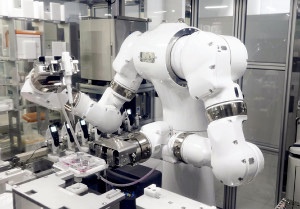

RIKEN: Automatic production of iPS cell tissue:
RIKEN in Kobe:
On June 27, a team such as RIKEN in Kobe announced.
From iPS cells
When “creating various organizations”,
There is a need to repeatedly perform detailed work such as injecting chemicals.
Traditionally, humans try and make mistakes:
There was no choice but to “find the best method by a skilled technician through trial and error.”
Combining AI and robots:
The robot follows the instructions of AI,
Drug concentration and
The speed at which the drug is injected, etc.
7 Items Change the conditions little by little.
Through trial and error, AI searched for the optimal procedure.
AI judgment
Robot culture
From a combination of 144 conditions
The robot cultivated according to the procedure that AI considered appropriate.
Automatic production of retinal cells:
“91% of iPS cells have changed to cells of the retina of the eye.”
Quality level of retinal cells:
This is “a quality level similar to that of a skilled technician”.
In fact, “the quality is comparable to that used in clinical research.”
RIKEN
Motoki Kanda Senior Researcher
If many experiments can be automated with this result, researchers can concentrate on other experiments.
It can accelerate research in the field of life science.
NHK Kansai News
https://www3.nhk.or.jp/kansai-news/20220628/2000062859.html
RIKEN : Production automatique de tissu cellulaire iPS :
RIKEN à Kobé :
Le 27 juin, une équipe comme RIKEN à Kobe a annoncé.
À partir de cellules iPS
Lors de la “création de diverses organisations”,
Il est nécessaire d’effectuer à plusieurs reprises des travaux détaillés tels que l’injection de produits chimiques.
Traditionnellement, les humains essaient et font des erreurs :
Il n’y avait pas d’autre choix que de “trouver la meilleure méthode par un technicien qualifié par essais et erreurs”.
Combiner IA et robots :
Le robot suit les instructions de l’IA,
Concentration de drogue et
La vitesse à laquelle le médicament est injecté, etc.
7 Articles Modifiez les conditions petit à petit.
Par essais et erreurs, l’IA a recherché la procédure optimale.
Jugement de l’IA
Culture robotique
D’une combinaison de 144 conditions
Le robot a cultivé selon la procédure que l’IA a jugée appropriée.
Production automatique de cellules rétiniennes :
“91 % des cellules iPS se sont transformées en cellules de la rétine de l’œil.”
Niveau de qualité des cellules rétiniennes :
C’est “un niveau de qualité similaire à celui d’un technicien qualifié”.
En fait, « la qualité est comparable à celle utilisée en recherche clinique ».
RIKEN
Motoki Kanda Chercheur principal
Si de nombreuses expériences peuvent être automatisées avec ce résultat, les chercheurs peuvent se concentrer sur d’autres expériences.
Il peut accélérer la recherche dans le domaine des sciences de la vie.
Nouvelles de la NHK Kansai
RIKEN: Automatische Produktion von iPS-Zellgewebe:
RIKEN in Kobe:
Am 27. Juni kündigte ein Team wie RIKEN in Kobe an.
Von iPS-Zellen
Beim „Schaffen verschiedener Organisationen“,
Es müssen wiederholt Detailarbeiten wie das Injizieren von Chemikalien durchgeführt werden.
Traditionell versuchen Menschen und machen Fehler:
Es blieb keine andere Wahl, als „von einem erfahrenen Techniker durch Versuch und Irrtum die beste Methode zu finden“.
Kombination von KI und Robotern:
Der Roboter folgt den Anweisungen der KI,
Wirkstoffkonzentration u
Die Geschwindigkeit, mit der das Medikament injiziert wird usw.
7 Items Ändere die Bedingungen nach und nach.
Durch Versuch und Irrtum suchte die KI nach dem optimalen Verfahren.
KI-Urteil
Roboterkultur
Aus einer Kombination von 144 Zuständen
Der Roboter kultivierte nach dem Verfahren, das die KI für angemessen hielt.
Automatische Produktion von Netzhautzellen:
„91 % der iPS-Zellen haben sich zu Zellen der Netzhaut des Auges verändert.“
Qualitätsniveau der Netzhautzellen:
Das sei „ein Qualitätsniveau ähnlich dem eines Fachhandwerkers“.
Tatsächlich “ist die Qualität mit der in der klinischen Forschung vergleichbar.”
RIKEN
Motoki Kanda Senior Researcher
Wenn mit diesem Ergebnis viele Experimente automatisiert werden können, können sich die Forscher auf andere Experimente konzentrieren.
Sie kann die Forschung im Bereich Life Science beschleunigen.
NHK Kansai-Nachrichten
Human-robot-AI teamwork accelerates regenerative medicine
RIKEN
A joint research group led by Genki Kanda at the RIKEN Center for Biosystems Dynamics Research (BDR)
has developed a robotic artificial intelligence (AI) system for autonomously determining the optimal conditions for growing replacement retina layers necessary for vision.
The AI controlled a trial and error process spanning 200 million possible conditions that succeeded in improving cell culture recipes used in regenerative medicine.
This achievement,
published in the scientific journal eLife on June 28, is just one example of how the automated design and execution of scientific experiments can increase the efficiency and speed of life science research in general.
To make this process more efficient and practical,
the BDR team
set out to develop an autonomous experimental system that can determine the optimal conditions and grow functional retinal pigment layers from stem cells.
Retinal pigment epithelium (RPE) cells
were chosen
because degeneration of these cells is a common age-related disorder that leaves people unable to see. Equally important, transplanted RPE retinal layers have already been shown to have some clinical success.
The new system accomplishes these goals using a general-purpose humanoid robot
– named Maholo –
capable of highly precise life science experimental behavior.
Maholo is controlled by AI software
that uses a newly designed optimization algorithm to determine which parameters should be changed, and how they should be changed, to improve differentiation efficiency in the next round of experiments.
https://www.riken.jp/en/news_pubs/research_news/pr/2022/20220628_2/index.html